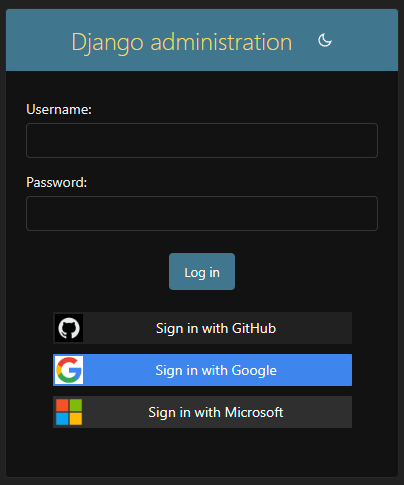Using Multiple Social Logins¶
A special advanced case is when you need to log in from multiple social providers. In this case, each provider will have its own package which you need to install and configure. Currently, we support:
Install the Packages¶
Install the packages you need:
pip install django-google-sso django-microsoft-sso django-github-sso
# Optionally install Stela to handle .env files
pip install stela
Add Package to Django Project¶
To add this package in your Django Project, please modify the INSTALLED_APPS in your settings.py:
# settings.py
INSTALLED_APPS = [
# other django apps
"django.contrib.messages", # Need for Auth messages
"django_github_sso", # Will show as first button in login page
"django_google_sso",
"django_microsoft_sso",
]
Order matters
The first package on list will be the first button in the login page.
Add secrets to env file¶
# .env
GOOGLE_SSO_CLIENT_ID=999999999999-xxxxxxxxx.apps.googleusercontent.com
GOOGLE_SSO_CLIENT_SECRET=xxxxxx
GOOGLE_SSO_PROJECT_ID=999999999999
MICROSOFT_SSO_APPLICATION_ID=FOO
MICROSOFT_SSO_CLIENT_SECRET=BAZ
GITHUB_SSO_CLIENT_ID=BAR
GITHUB_SSO_CLIENT_SECRET=FOOBAR
Setup Django URLs¶
Add the URLs of each provider to your urls.py file:
from django.urls import include, path
urlpatterns += [
path(
"github_sso/",
include("django_google_sso.urls", namespace="django_github_sso"),
),
path(
"google_sso/",
include("django_github_sso.urls", namespace="django_google_sso"),
),
path(
"microsoft_sso/",
include("django_github_sso.urls", namespace="django_microsoft_sso"),
),
]
Setup Django Settings¶
Add the settings of each provider to your settings.py file:
# settings.py
from stela import env
# Django Microsoft SSO
MICROSOFT_SSO_ENABLED = True
MICROSOFT_SSO_APPLICATION_ID = env.MICROSOFT_SSO_APPLICATION_ID
MICROSOFT_SSO_CLIENT_SECRET = env.MICROSOFT_SSO_CLIENT_SECRET
MICROSOFT_SSO_ALLOWABLE_DOMAINS = ["contoso.com"]
# Django Google SSO
GOOGLE_SSO_ENABLED = True
GOOGLE_SSO_CLIENT_ID = env.GOOGLE_SSO_CLIENT_ID
GOOGLE_SSO_PROJECT_ID = env.GOOGLE_SSO_PROJECT_ID
GOOGLE_SSO_CLIENT_SECRET = env.GOOGLE_SSO_CLIENT_SECRET
GOOGLE_SSO_ALLOWABLE_DOMAINS = ["contoso.net"]
# Django GitHub SSO
GITHUB_SSO_ENABLED = True
GITHUB_SSO_CLIENT_ID = env.GITHUB_SSO_CLIENT_ID
GITHUB_SSO_CLIENT_SECRET = env.GITHUB_SSO_CLIENT_SECRET
GITHUB_SSO_ALLOWABLE_ORGANIZATIONS = ["contoso"]
The login page will look like this:

You can hide the login form
If you want to show only the SSO buttons, you can hide the login form using the SSO_SHOW_FORM_ON_ADMIN_PAGE setting.
Avoiding duplicated Users¶
Both Django GitHub SSO and Django Microsoft SSO can create users without an email address, comparing the User username
field against the Azure User Principal Name or Github User Name. This can cause duplicated users if you are using either package.
To avoid this, you can set the MICROSOFT_SSO_UNIQUE_EMAIL and GITHUB_SSO_UNIQUE_EMAIL settings to True,
making these packages compare User email against Azure Mail field or Github Primary Email. Make sure your Azure Tenant
and GitHub Organization users have registered emails.
The Django E003/W003 Warning¶
If you are using multiple Django SSO projects, you will get a warning like this:
WARNINGS:
?: (templates.E003) 'show_form' is used for multiple template tag modules: 'django_google_sso.templatetags.show_form', 'django_microsoft_sso.templatetags.show_form'
?: (templates.E003) 'sso_tags' is used for multiple template tag modules: 'django_google_sso.templatetags.sso_tags', 'django_microsoft_sso.templatetags.sso_tags'
This is because both packages use the same template tags. To silence this warning, you can set the SILENCED_SYSTEM_CHECKS as per Django documentation:
But if you need to check the templates, you can use the SSO_USE_ALTERNATE_W003 setting to use an alternate template tag. This alternate check will
run the original check, but will not raise the warning for the Django SSO packages. To use this alternate check, you need to set both the Django Silence Check and SSO_USE_ALTERNATE_W003: